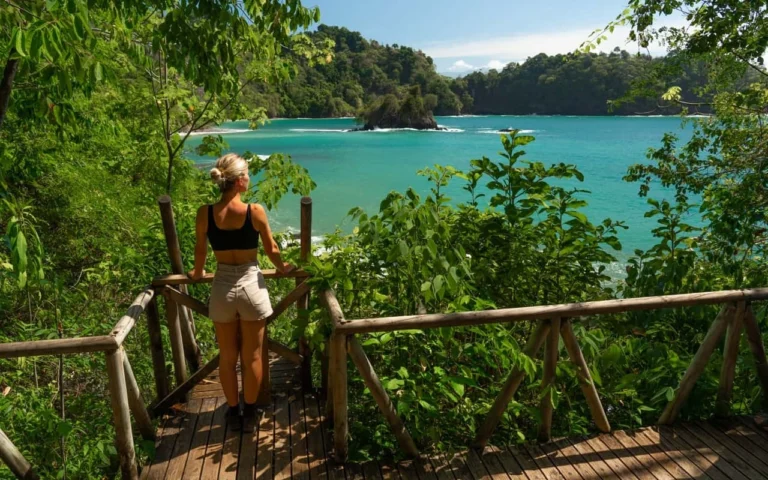Costa Rica's Green Season: What's Covered
Costa Rica’s green season runs May through November, bringing 20-40% lower accommodation rates and dramatically fewer crowds than the dry months. The “rainy season” label misleads—most areas see sunny mornings followed by predictable afternoon showers lasting 1-3 hours. Having your own vehicle lets you chase good weather between regions and access remote properties that become even more spectacular when the landscape transforms to vibrant green.
Quick Facts:
- Save 20-40% on accommodations plus 10-25% on car rentals compared to December-April rates
- Rainfall follows predictable patterns—clear mornings, afternoon showers, then evening clearing in most regions
- July-August brings “veranillo” (little summer) with noticeably less rain but low-season prices
- The Caribbean coast (Puerto Viejo, Tortuguero) enjoys its driest period, September-October, when the Pacific side sees the heaviest rainfall
- Wildlife viewing actually improves as animals become more active and the breeding season peaks
Top 5 Times to Visit Green Season:
- May – Landscape transforms from brown to green, moderate rain, dramatic tourism drop creates excellent value
- June-July – Reliable morning sunshine establishes a typical green season rhythm, vibrant landscapes without the heaviest rains
- July-August – “Little summer” phenomenon brings decreased rainfall, slightly busier but still excellent conditions countrywide
- September-October – Heaviest Pacific rainfall but Caribbean coast at its best, perfect for split-destination trips
- November – Transitional month combines lush green scenery with decreasing rain, last chance for low-season rates
A 4×4 rental becomes essential for accessing Monteverde, parts of the Nicoya Peninsula beaches, and many remote lodges during the green season—but the flexibility to relocate when storms settle in makes having your own vehicle the smartest choice regardless of destination.
If you need any help with a Costa Rica car rental, contact us now!
Thinking about visiting Costa Rica between May and November? You might have heard this called the “rainy season” or “low season,” but locals know it as “green season” – and for good reason. After guiding thousands of travelers through Costa Rica year-round, I can tell you that the green season offers a completely different (and often better) experience than the popular dry months.
Many travelers avoid the green season because they’re worried about rain ruining their vacation. The truth? With smart planning, the green season can offer the perfect blend of better prices, fewer crowds, and stunning natural beauty. You’ll just need to know a few insider strategies to work around the afternoon showers.
Let me walk you through the real advantages and challenges of a green season visit, plus practical tips to maximize your experience during this special time of year. Whether you’re a wildlife enthusiast, budget traveler, or just looking to experience Costa Rica at its most lush and vibrant, this guide will help you decide if green season is right for your trip.

What Exactly Is Costa Rica's Green Season and Why Should You Care?
The green season typically runs from May through November, with rainfall patterns varying by region and month. The name comes from the dramatic transformation that occurs – brown, dusty landscapes of the dry season explode into a thousand shades of green within weeks of the first rains.
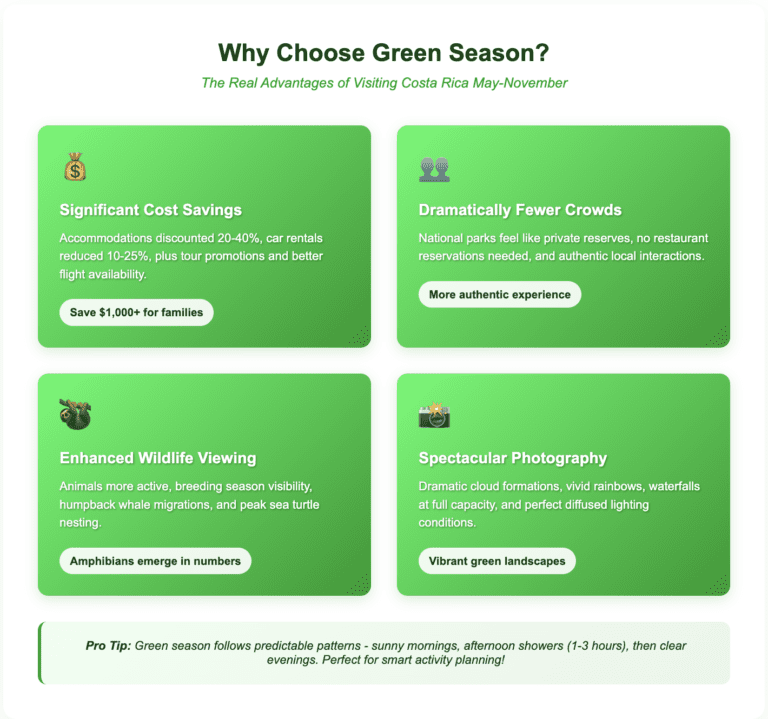
What many travelers don’t realize is that green season rarely means day-long downpours. Instead, most regions follow a predictable pattern: clear, sunny mornings followed by afternoon showers that typically last 1-3 hours before clearing again. This pattern actually makes planning activities quite manageable once you understand it.
How Does Green Season Actually Work Month by Month?
May and June bring the first rains, transitioning the country from brown to green. July and August offer what locals call “veranillo” (little summer) with a noticeable decrease in rainfall. September and October see the heaviest precipitation on the Pacific side, while the Caribbean coast often enjoys its driest period – an important regional difference we’ll explore later. By November, the rains begin tapering off as the country transitions back to dry season.
The reason for this pattern? Costa Rica sits in the convergence zone between northern and southern hemispheres, creating this distinct six-month cycle. This same position gives the country its incredible biodiversity, which actually becomes more visible during the green season.
Why Do Smart Travelers Choose Green Season?
How Much Money Can You Actually Save?
Let’s start with the most obvious benefit – your travel budget goes significantly further. During green season, you’ll find:
- Accommodations discounted 20-40% from peak season rates
- Car rental prices reduced by 10-25% with better vehicle availability
- Many tours offer green season promotions or small-group discounts
- Domestic flights often available at lower rates with last-minute availability
These savings aren’t just marketing gimmicks – they reflect the real decrease in demand despite conditions that are still excellent for most activities. For a family of four staying for 10 days, this can easily translate to $1,000+ in savings.
What’s It Like Having Costa Rica Almost to Yourself?
Perhaps even more valuable than the cost savings is the improved experience that comes with fewer visitors:
- National parks with a fraction of high-season crowds (Manuel Antonio feels like a private reserve)
- No need for restaurant reservations in most towns
- Wildlife viewing without competing with dozens of other tourists
- Popular attractions like La Fortuna Waterfall or Monteverde’s hanging bridges with minimal wait times
- Surf breaks without other surfers competing for the waves
- Drive with less traffic on the roads compared to busy periods when the Central Valley empties to the beach
This difference is most striking if you’ve previously visited during peak weeks like Christmas or Easter, when popular spots can feel genuinely overcrowded. Green season provides a more authentic experience where you can appreciate natural attractions without the constant presence of other tourists.
Why Is Wildlife Viewing Actually Better in the Green Season?
Contrary to what many assume, green season often provides superior wildlife viewing opportunities:
- Animals become more active as they don’t need to conserve energy from heat which is a huge bonus for sloth lovers
- Many species breed during this season, making them more visible
- Amphibians emerge in tremendous numbers (especially frogs)
- Humpback whales migrate along the Pacific coast (July-October)
- Sea turtle nesting peaks at various beaches
In Monteverde, the cloud forest actually lives up to its name during the green season, with mystical fog weaving through moss-covered trees. Resplendent quetzals and hundreds of other bird species are more active and visible as they feed on abundant insects and fruits.
What Makes the Green Season Perfect for Photography?
If you’re interested in photography, green season offers conditions that simply don’t exist during dry months:
- Dramatic cloud formations during afternoon thunderstorms
- Vivid rainbows following showers
- Waterfalls at full, thundering capacity
- Perfect diffused light from cloud cover without harsh shadows
- Lush, vibrant landscapes that showcase Costa Rica’s famous biodiversity
The most remarkable sunsets happen during green season, when late afternoon storms clear just before dusk, creating spectacular red and orange skies that reflect off the clouds.
What Are the Real Challenges and How Do You Handle Them?
I wouldn’t be giving you the complete picture without addressing the challenges of green season travel. Here are the honest drawbacks and practical solutions:
How Do You Work Around the Rain Patterns?
The primary challenge is obvious – rain will be part of your experience. However, it’s manageable with smart scheduling:
- Plan major activities for mornings (6-11 am) when skies are typically clearest
- Keep afternoons flexible for indoor activities or relaxation during typical shower times
- Choose accommodations with covered outdoor spaces to enjoy the rain rather than hide from it
- Use the predictable rain window to enjoy spa treatments, naps, or reading time
Many travelers actually come to appreciate the rhythm of green season days – active mornings, relaxing afternoons during rain, then back out for evening activities after the showers pass.
What About Road Conditions and Getting Around?
Some secondary roads become challenging during heavy rains, especially in remoter areas:
- Unpaved roads may develop significant ruts and mud sections
- Landslides occasionally close mountain routes for several hours
- Some remote areas may have temporarily impassable sections after heavy rains
These challenges are easily managed by:
- Renting a 4×4 vehicle, particularly if you’re visiting mountainous regions like Monteverde
- Building extra time into your itinerary for potential delays
- Using the Waze app which is constantly updated by locals with current road conditions
- Planning key journeys for morning hours when conditions are typically better
Having your own vehicle provides tremendous flexibility during the green season. If rain is heavy in one location, you can often drive 30-60 minutes to find completely different weather conditions.
Can You Still Enjoy the Beaches?
If your primary goal is all-day beach lounging, green season does present some limitations:
- Afternoon showers may interrupt beach time
- Pacific Ocean conditions can be rougher with stronger currents
- Occasional storm systems might bring multiple days of rain
However, beach lovers can still enjoy green season by:
- Focusing on morning beach activities when skies are clearest
- Considering the Caribbean coast in September-October (when it experiences its unique dry period)
- Embracing other activities during the predictable afternoon rain windows
- Taking advantage of significantly discounted beachfront accommodations
Where Should You Go During the Green Season?
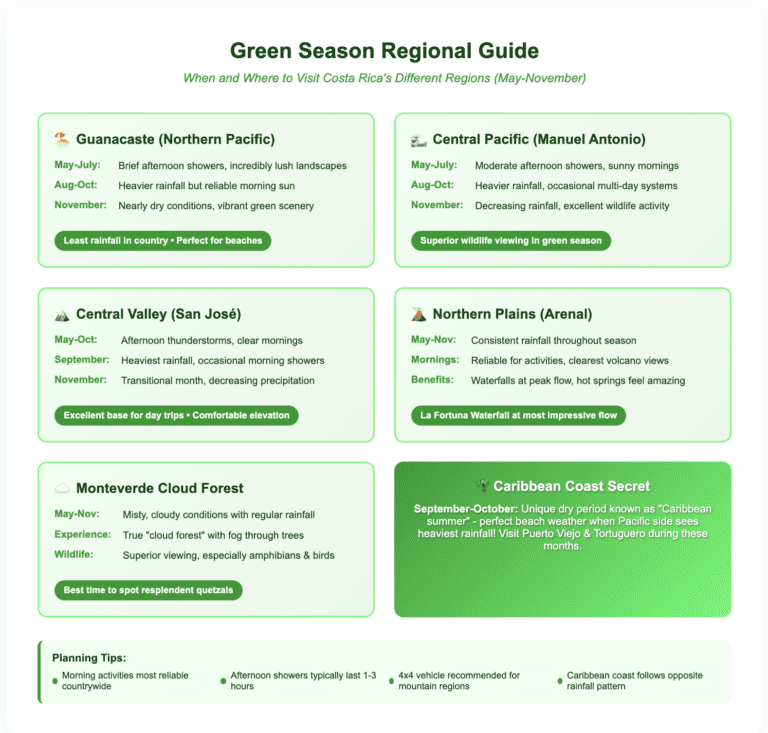
Costa Rica’s green season looks different depending on where you are in the country. This regional variation is your secret weapon for planning a fantastic green season experience:
Why Is Guanacaste Perfect for Green Season Beginners?
- May-July: Ideal timing with brief afternoon showers and incredibly lush landscapes
- August-October: Heavier rainfall but still with reliable morning sun
- November: Nearly back to dry conditions but with vibrant green scenery
Guanacaste receives the least rainfall in the country, making it an excellent green season destination. The famous beaches around Tamarindo and the Papagayo Peninsula often see rain for just 1-2 hours in the late afternoon, with sunshine dominating the rest of the day.
How Does the Central Pacific Handle Green Season?
Central Pacific (Manuel Antonio, Jacó):
- May-July: Moderate afternoon showers with consistently sunny mornings
- August-October: Heavier rainfall with occasional multi-day systems
- November: Decreasing rainfall with excellent wildlife activity
The Central Pacific region sees more significant rainfall than Guanacaste but maintains a fairly reliable pattern of clear mornings and afternoon showers. Wildlife viewing in Manuel Antonio National Park is superior during the green season, with the abundant rainfall supporting more active animal populations.
What Makes the Central Valley Great Year-Round?
Central Valley (San José, Alajuela):
- May-October: Afternoon thunderstorms common, but generally clear mornings
- September: Heaviest rainfall month, with occasional morning showers
- November: Transitional month with decreasing precipitation
The Central Valley’s elevation creates a comfortable climate year-round, with green season bringing dramatic afternoon thunderstorms that typically clear by evening. This region makes an excellent home base for day trips during green season.
When Is the Caribbean Coast at Its Best?
Caribbean Coast (Puerto Viejo, Tortuguero):
- May-August: Rainfall common but typically in short bursts
- September-October: Uniquely dry period known as “Caribbean summer”
- November: Rainfall increases as the rest of the country dries out
The Caribbean coast follows a different pattern than the rest of Costa Rica, with its driest period falling during September and October – precisely when the Pacific side sees its heaviest rainfall. This creates a perfect opportunity for savvy travelers to enjoy beach time when the rest of the country is at its wettest. Visitors to Tortuguero traveling by boat to the roadless town will have a smoother ride on the rain-filled canals which can dry up during dry season.
How Does Arenal Handle the Rainy Months?
Northern Plains (Arenal, Sarapiquí):
- May-November: Consistent rainfall throughout green season
- Morning activities still highly reliable with clearest volcano views early in the day
- Abundant waterfalls and rainforest activities thrive with increased rainfall
The Arenal region remains relatively wet throughout the green season, but the rain enhances many of the area’s top attractions – hot springs feel even better during cool rainy afternoons, and La Fortuna Waterfall reaches its most impressive flow during these months.
What’s Special About Monteverde in the Green Season?
- May-November: Misty, cloudy conditions with regular rainfall
- True “cloud forest” experience with fog moving through the trees
- Superior wildlife viewing, especially for amphibians and birds
Monteverde actually becomes more mysterious and atmospheric during the green season, with the clouds and mist creating the perfect environment to spot elusive species like the resplendent quetzal. The hanging bridges offer an incredible experience as you walk through the clouds at the level of the forest canopy.
When Should You Visit for the Best Green Season Experience?
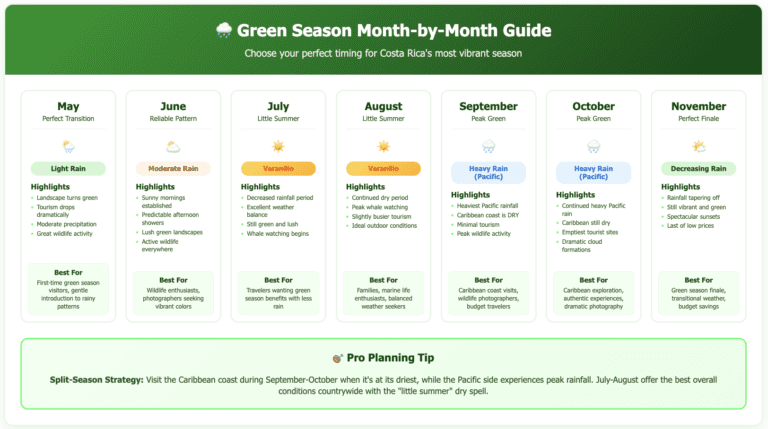
Is May the Perfect Introduction Month?
May offers an ideal introduction to the green season. The first rains transform the landscape from brown to green, but precipitation remains moderate. Tourism drops dramatically after Easter, creating a sweet spot of good weather, green landscapes, and low crowds.
Recommended regions: Anywhere in the country works well, but Guanacaste and the Central Pacific are particularly good choices.
Pro tip: Look for “green season kickoff” deals at many hotels as they transition from high to low season pricing.
Why Do June and July Offer the Most Reliable Conditions?
These months establish the typical green season pattern of sunny mornings and afternoon showers. Wildlife activity increases dramatically, and you’ll experience vibrant green landscapes without the heaviest rains that come later.
Recommended regions: The entire Pacific coast works well, with Guanacaste seeing the least rainfall. Monteverde offers amazing cloud forest conditions.
Pro tip: Book outdoor activities for 7-11am when weather is most reliable, leaving afternoons for hot springs, spa treatments, or museum visits.
What Makes July and August Costa Rica’s Best-Kept Secret?
Many locals consider July and August as some of the best months in Costa Rica. A phenomenon called “Veranillo de San Juan” (St. John’s Little Summer) often brings a noticeable decrease in rainfall mid-July to early August. Combined with the European vacation season and Costa Rican mid-year school break, this makes July and August slightly busier than other green season months.
Recommended regions: Good conditions throughout the country, with the Central Valley and Guanacaste particularly pleasant.
Pro tip: Book accommodations a bit further in advance for July and August, as this “secret” has become more widely known.
Why Are September and October Perfect for Advanced Travelers?
These months see the heaviest rainfall on the Pacific side but create opportunities for travelers willing to adapt. Wildlife viewing reaches its peak, and the dramatically reduced tourism creates a completely different experience at popular destinations.
Recommended regions: The Caribbean coast enjoys its driest period during these months – the perfect time to visit Puerto Viejo and Cahuita.
Pro tip: This is the time for a “split destination” trip – combine the Caribbean coast with Arenal/Northern Plains for the optimal weather balance.
How Does November Give You the Best of Both Worlds?
As the green season winds down, November offers an excellent compromise: vibrant green landscapes with decreasing rainfall, but still with low season prices. The transitional weather creates spectacular cloud formations and sunsets.
Recommended regions: Countrywide good conditions, with the Pacific beaches beginning to dry out while still maintaining their lush backdrop.
Pro tip: Book before US Thanksgiving to enjoy the last of the low season rates before high season kicks in.
What Should You Pack for Green Season Success?
Packing properly for green season requires a slightly different approach:
What Are the Absolute Must-Have Items?
- Quick-dry clothing: Pack synthetic or performance fabrics that dry quickly after getting wet
- Waterproof phone case/dry bag: Protect electronics from sudden downpours
- Proper rain jacket: Look for truly waterproof (not just water-resistant) with ventilation
- Second pair of footwear: Allow one pair to dry while wearing the other
- Insect repellent: Mosquitoes are more prevalent during green season
What Do Most People Forget to Pack?
- Waterproof watch or small clock: Phone batteries can drain quickly with heavy use and might not always be accessible
- Flashlight/headlamp: Occasional power outages during storms are brief but happen
- Ziplock bags: Perfect for protecting documents, electronics, or anything sensitive to humidity as well as a dry pair of socks
- Light jacket/sweater: Temperatures can drop noticeably during heavy rain
- Portable battery pack: Keep devices charged when you might not want to plug in during a thunderstorm
Where Should You Stay During the Green Season?
Where you stay during green season becomes even more important than during dry months:
What Location Factors Matter Most?
- Elevation: Higher elevation properties often sit in the clouds during green season
- Road access: Some remote lodges may have challenging access during heavy rains so check if a 4×4 is needed
- Covered outdoor spaces: Essential for enjoying the surroundings even during showers
How Can You Get the Best Green Season Deals?
- Request rooms with views/balconies: You’ll spend more time in your room during rain
- Look for “green season packages”: Many hotels offer special rates or added values
- Consider upgrade opportunities: Luxury rooms often see the steepest discounts
- Check for covered walkways: Getting from your room to restaurant without getting wet
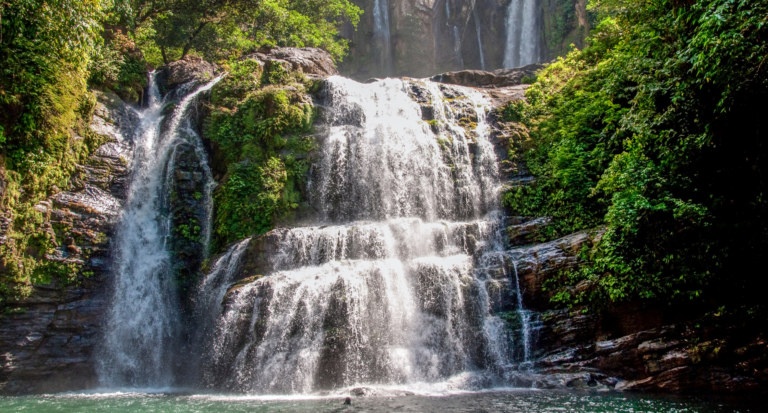
Which Activities Actually Get Better with Rain?
Some Costa Rican experiences are actually better during green season:
What Water-Based Adventures Improve?
- Whitewater rafting: Rivers run higher and faster, creating more exciting conditions
- Waterfall visits: Seeing La Fortuna or Nauyaca waterfalls at full volume is spectacular
- Hot springs: The naturally heated pools feel even better during cooler rainy afternoons
How Does Green Season Enhance Wildlife Encounters?
- Night tours: Amphibians become incredibly active after rainfall
- Bird watching: Many species nest during green season which increases activity
- Turtle nesting: Multiple beaches host nesting turtles during these months
- Whale watching: Humpbacks migrate along the Pacific coast July-October
Why Are Photography Opportunities Better?
- Cloud forest conditions: Mystical fog and clouds create atmospheric photos
- Empty beaches: Capture Pacific sunsets without crowds in the frame
- Dramatic skies: Storm clouds create dimension and drama impossible during dry season
How Should You Get Around During the Green Season?
How you get around Costa Rica during green season requires some strategic thinking:
Why Does a Rental Car Make the Biggest Difference?
Having your own vehicle provides unmatched flexibility during the green season. You can:
- Chase good weather by easily relocating when storms settle in
- Wait out brief showers in your car rather than being stuck on public transportation
- Access remote locations where shuttles or buses run less frequently during low season
- Store extra gear (dry clothes, camera equipment) securely between destinations
For green season, we strongly recommend:
- 4×4 rental: Essential for accessing Monteverde, parts of the Nicoya Peninsula, and many lodge properties
- Adding the Waze Smartphone option: Helps navigate detours that occasionally become necessary
- Windshield coverage: Green season sees more debris on roads from winds and rain
At Vamos Rent-A-Car, we provide all green season rentals with detailed advice on watchouts and precautions for driving.
When Do Domestic Flights Make More Sense?
For longer distances, consider domestic flights on Sansa or Green Airways:
- Avoid potential road delays during heavy rainfall periods
- Enjoy spectacular aerial views of the lush green landscapes
- Access destinations like Tortuguero that are primarily reached by boat/plane
- Maximize your vacation time with quick 30-60 minute flights vs. 4-6 hour drives
Green season typically sees better availability on domestic flights, often allowing last-minute bookings that would be impossible during high season. Arrange car rental pick up or drop off at national airports for a nominal fee.

Is Green Season Right for Your Travel Style?
After helping thousands of travelers experience Costa Rica during both seasons, I can tell you that green season tends to be perfect for:
- Wildlife enthusiasts: Animals are more active and visible
- Photographers: Dramatic lighting and vibrant colors create superior conditions
- Budget-conscious travelers: Experience the same Costa Rica for significantly less
- Travelers who value authenticity: Fewer tourists means more local interactions
- Flexible itineraries: If you can adapt to weather patterns rather than rigid schedules
Green season might be challenging if:
- Your primary goal is all-day beach lounging (though morning beach time works well)
- You’re visiting extremely remote areas where road access can be compromised
- You have very limited time and need guaranteed perfect weather for specific activities
Ready to Plan Your Green Season Adventure?
If you’re considering a green season visit to Costa Rica, here’s how to move forward:
- Identify your timing: May-July and November offer the gentlest introduction to the green season
- Choose your regions strategically: Consider the Caribbean coast for September-October, or focus on Guanacaste for the driest green season experience
- Secure your transportation: A rental car provides maximum flexibility to adapt to changing weather conditions
- Book accommodations with covered outdoor spaces: Look for properties with covered terraces, indoor-outdoor living areas, or hot tubs/pools accessible during rain
- Structure your daily itinerary: Plan morning activities when the weather is most reliable, with flexible afternoon alternatives
Ready to explore Costa Rica during its most vibrant, affordable, and authentic season? Contact us at Vamos Rent-A-Car to secure your vehicle with our green season discounts and complimentary weather advisory service. Our local expertise means we can help you select the perfect vehicle for your green season route, ensuring you enjoy all the benefits while minimizing any challenges.
Green season isn’t just about saving money – it’s about experiencing a different, more vibrant Costa Rica that many tourists never get to see. With the right planning and local knowledge, you might find it’s actually the best time to visit paradise.
¡Pura vida!
